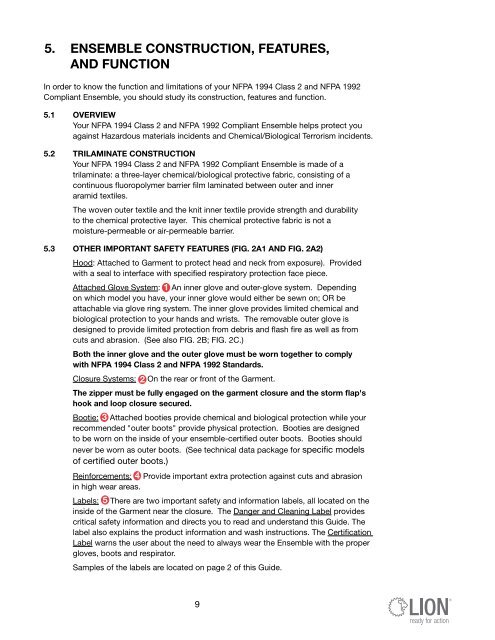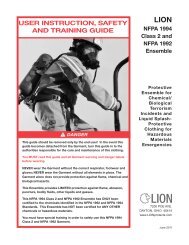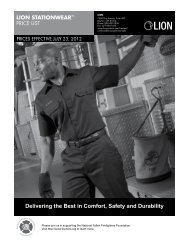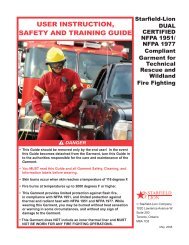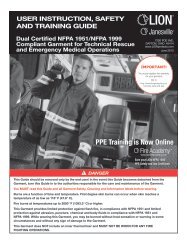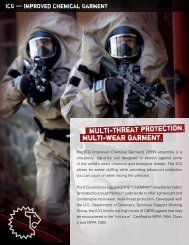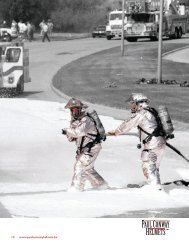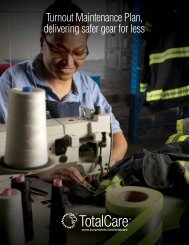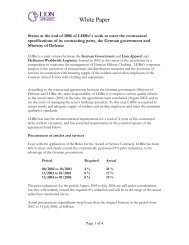Create successful ePaper yourself
Turn your PDF publications into a flip-book with our unique Google optimized e-Paper software.
5. ENSEMBLE CONSTRUCTION, FEATURES,<br />
AND FUNCTION<br />
In order to know the function and limitations of your NFPA 1994 Class 2 and NFPA 1992<br />
Compliant Ensemble, you should study its construction, features and function.<br />
5.1 OVERVIEW<br />
Your NFPA 1994 Class 2 and NFPA 1992 Compliant Ensemble helps protect you<br />
against Hazardous materials incidents and Chemical/Biological Terrorism incidents.<br />
5.2 trilaminate construction<br />
Your NFPA 1994 Class 2 and NFPA 1992 Compliant Ensemble is made of a<br />
trilaminate: a three-layer chemical/biological protective fabric, consisting of a<br />
continuous fluoropolymer barrier film laminated between outer and inner<br />
aramid textiles.<br />
The woven outer textile and the knit inner textile provide strength and durability<br />
to the chemical protective layer. This chemical protective fabric is not a<br />
moisture-permeable or air-permeable barrier.<br />
5.3 OTHER IMPORTANT SAFETY FEATURES (FIG. 2a1 and fig. 2a2)<br />
Hood: Attached to Garment to protect head and neck from exposure). Provided<br />
with a seal to interface with specified respiratory protection face piece.<br />
Attached Glove System: 1 An inner glove and outer-glove system. Depending<br />
on which model you have, your inner glove would either be sewn on; OR be<br />
attachable via glove ring system. The inner glove provides limited chemical and<br />
biological protection to your hands and wrists. The removable outer glove is<br />
designed to provide limited protection from debris and flash fire as well as from<br />
cuts and abrasion. (See also FIG. 2B; FIG. 2C.)<br />
Both the inner glove and the outer glove must be worn together to comply<br />
with NFPA 1994 Class 2 and NFPA 1992 Standards.<br />
Closure Systems: 2 On the rear or front of the Garment.<br />
The zipper must be fully engaged on the garment closure and the storm flap's<br />
hook and loop closure secured.<br />
Bootie: 3 Attached booties provide chemical and biological protection while your<br />
recommended "outer boots" provide physical protection. Booties are designed<br />
to be worn on the inside of your ensemble-certified outer boots. Booties should<br />
never be worn as outer boots. (See technical data package for specific models<br />
of certified outer boots.)<br />
Reinforcements: 4 Provide important extra protection against cuts and abrasion<br />
in high wear areas.<br />
Labels: 5 There are two important safety and information labels, all located on the<br />
inside of the Garment near the closure. The Danger and Cleaning Label provides<br />
critical safety information and directs you to read and understand this <strong>Guide</strong>. The<br />
label also explains the product information and wash instructions. The Certification<br />
Label warns the user about the need to always wear the Ensemble with the proper<br />
gloves, boots and respirator.<br />
Samples of the labels are located on page 2 of this <strong>Guide</strong>.<br />
9


